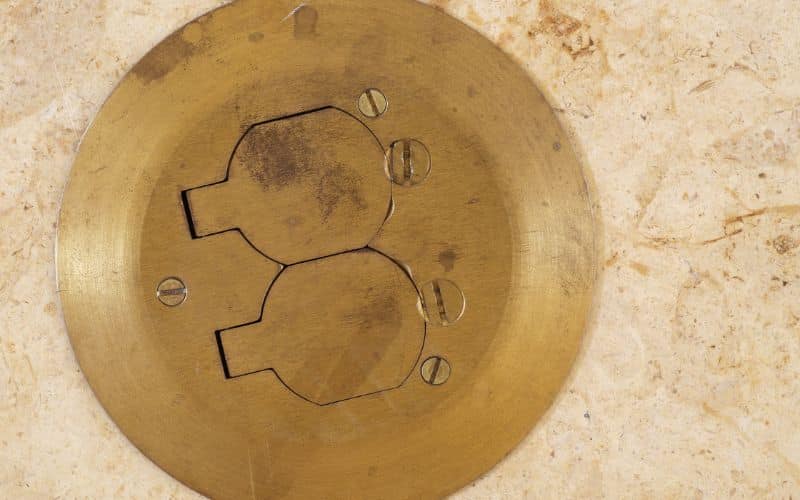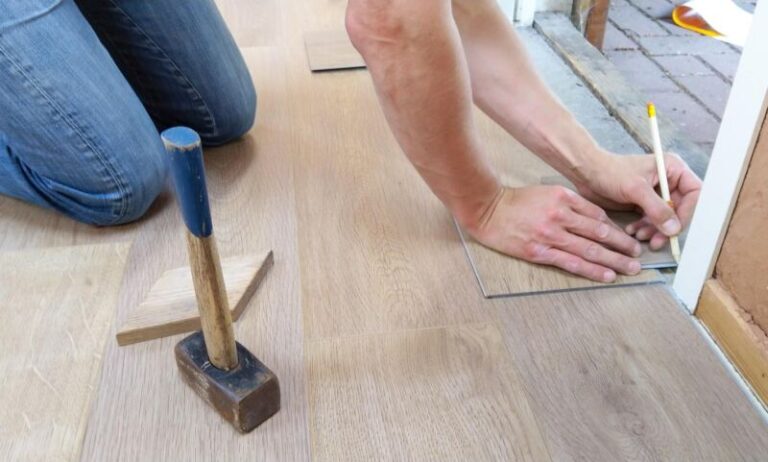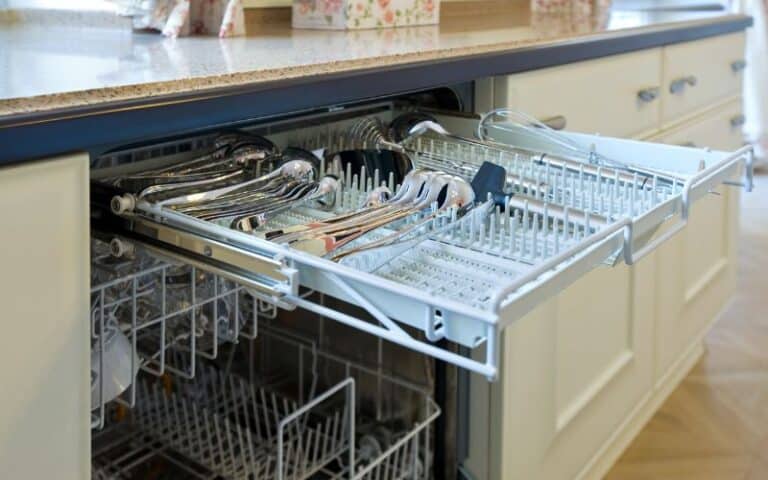Using floor outlet covers is convenient for arranging your electrical outlets in open areas, whether at your workplace or home.
You can easily attach them flush with the floor so they remain unobtrusive, thereby avoiding any mishaps.
Getting the process right is essential to prevent any dangerous situations like fire outbreaks or electrical shocks.
Thus, here are five easy steps you can take to avoid any hazards while opening floor outlet covers.
First, identify and locate the floor outlet you plan to open. Next, remove any obstructions, such as a piece of rug or furniture. Then, use a screwdriver to pry open the cover. Lastly, disconnect any electrical connections. Now, lift the cover off its frame, access the outlet below, and make the necessary repairs.
The process of opening an outlet cover may seem tedious, especially if you have no expertise. But, by the end of this guide, you should have no problem with the process anymore.
Ready for a Flooring Quiz?
5 Steps For Opening a Floor Outlet Cover

By following the right procedure or steps, you should have no difficulties opening the outlet cover of your floor.
Now, follow these five easy steps you should follow to safely open your floor outlet cover:
#1. Locate The Floor Outlet Cover
To locate and open a floor outlet cover, you need to follow certain steps. First, find the location of the recessed floor outlet box.
The spot is usually indicated by a small round or rectangular metal plate. Once you have located the plate, use a screwdriver or similar tool to remove it.
This tool should expose the cover of the floor outlet box, which you can then open by lifting it or pulling it out.
After opening the cover, you should have access to the electrical outlet itself. Using the original manufacturer’s outlet cover is best to keep debris from getting into the outlet.
#2. Remove Obstructions
While removing obstructions can make it easier to access an electrical outlet cover, it’s important to note that a certified electrician should perform any work on electrical systems.
Additionally, removing obstructions that are blocking access to an electrical outlet cover should be done with caution.
As there may be other electrical components or wires nearby that can be damaged or pose a risk of electrocution.
So, if you need to access an electrical outlet cover and there are obstructions in the way, it’s best to consult with a certified electrician to ensure that the work is done safely and correctly.
#3. Use a Screwdriver
Here, care must be taken not to break any tabs or damage the cover. It’s best to use a rag or tape to protect the screwdriver before attempting to pry open the cover.
Also, it may be helpful to push down on the cover with a finger while prying it open. To open a floor outlet cover using a screwdriver, you can follow these general steps:
- Locate the screws: The cover plate of a floor outlet is typically attached to screws. Locate and identify the screws before proceeding.
- Remove the screws: Use a screwdriver that fits the screw head and turn it counterclockwise to remove the screws. Set them aside in a safe place in case you need them later.
- Lift the cover plate: Once the screws are removed, the cover plate should come off easily. You may need to gently pry it open with a flathead screwdriver if it doesn’t.
- Access the outlet: With the cover plate removed, you should now be able to access the electrical outlet itself.
It’s worth noting that specific instructions may vary depending on your floor outlet type.
If you’re unsure about how to proceed, you may want to consult a professional electrician to avoid damaging the outlet or risking your safety.
#4. Disconnect Electrical Appliances
Always disconnect electrical appliances before opening any outlet cover to avoid possible electrical accidents.
The applicable electrical codes and standards, such as the National Electrical Code (NEC), also require procedures for electrical safety.
Similarly, the Occupational Safety and Health Administration (OSHA) demands such safety measures too.
In addition, OSHA requires employers to train their workers on the proper use of electrical equipment, including disconnecting it before opening any outlet cover.
Therefore, following these safety standards and disconnecting any electrical appliances before opening any outlet covers is the best practice.
Opening a floor outlet cover can expose electrical wires and components, which can be dangerous if they have currents in them.
By disconnecting electrical appliances before opening an outlet, you ensure that no electricity is flowing through the wires or components you may come into contact with.
Doing this helps prevent electric shock and other electrical hazards. In general, it’s important to follow proper safety precautions when working with electrical equipment
Also, you should always disconnect equipment from power sources before performing any maintenance or repairs.
Here are the steps for disconnecting your electrical appliances;
- Turn off and unplug the electrical appliance before attempting to remove the floor outlet cover.
- You can remove the floor outlet cover once the electrical appliance is unplugged. Use a screwdriver to carefully unscrew the screws holding the cover in place.
- Removing the floor outlet cover allows you to access the electrical outlet and plug, if necessary. You can then disconnect any electrical appliance plugged into the outlet.
- If you need to remove the plug from the outlet, pull the plug instead of the cord to avoid damaging the cord or outlet.
- Once you have disconnected the electrical appliance, you can replace the floor outlet cover and screw it back with the screwdriver.
Following these steps is important to ensure that electrical appliances are safely disconnected.
It’s best to do this before removing the floor outlet cover to prevent any electrical hazards or damage to the appliances, cords, or outlets.
#5. Remove Obstructions
Removing any obstructions before opening a floor outlet cover is a good idea to avoid any damage or interference with the electrical components.
However, it’s important to make sure that the area is safe to work in before doing so.
Therefore, it’s ideal that you turn off the electrical power to the outlet at the circuit breaker before removing the cover.
Additionally, you should visually inspect the area for any potential hazards or obstructions, such as furniture or debris.
If you do encounter any obstructions, it’s best to remove them before attempting to remove the outlet cover.
Why is my Floor Outlet Cover Not Opening?
Difficulties opening your outlet cover could indicate an issue arising from a faulty tripped circuit breaker and even from the overall wiring of your home.
On this note, here are six potential reasons why electrical outlet covers may not function properly:
#1. Tripped Circuit Breaker
If an electrical outlet isn’t working, the first thing to check is your circuit breaker. Circuit breakers control the electricity flowing to each room in your house.
Similarly, a tripped circuit breaker can cause an outlet to stop working. Simply flip the circuit breaker switch to the “on” position to reset it.
#2. Faulty Appliance/Plug
Faulty appliances or plugs can also prevent an electrical outlet from working. If an appliance or plug seems to be the issue.
Try unplugging it from the outlet and plugging it into a different device to see if it works.
#3. Loose Connection
Loose connecting wires can cause an outlet to lose power. If you’ve gone through the previous troubleshooting steps but still don’t have power, the outlet’s connections may be loose.
You may want to call an electrician to fix it in such a situation.
#4. Overloaded Outlet
An overloaded outlet can also prevent an electrical outlet from working. This can happen if too many devices are plugged into the outlet at once, causing it to trip.
Here, unplugging some devices and trying the outlet again should help.
#5. Burned Out Outlet
A burned-out outlet can also cause an electrical outlet to stop functioning. This can happen if the outlet is old or has been damaged in some way. In this case, it’s best to replace the outlet.
#6. Faulty Wiring
Faulty wiring can also prevent an electrical outlet from working. This can happen if the wiring is old or has been damaged, causing the outlet to lose power.
In such a case, calling an electrician to fix the wiring is necessary.
How Do You Remove a Floor Outlet Cover Without Screws?
If you have a floor outlet without screws, removing the cover can be a little tricky. However, you can still do it with the right tools and techniques.
One method is to use a flathead screwdriver and gently pry the cover off. Start by wedging the screwdriver between the edge of the cover and the outlet box.
Then, gently apply pressure and slowly work your way around the edge of the cover to gradually loosen it. Be careful not to apply too much pressure and damage the cover or the box.
Another method is to use a suction cup or a strong adhesive tape. Place the suction cup or tape on the center of the cover and pull it up to detach it from the box.
This method may be a little easier on the cover and box but may require a fairly strong suction cup or tape.
If neither of these methods works, some other hidden mechanism may hold the cover in place, such as plastic clips or latches.
In this case, it may be necessary to consult the manufacturer’s instructions or seek professional assistance.
It’s important to note that before attempting to remove the cover, you should ensure the power to the outlet is turned off.
Can Anyone Replace the Floor Outlet Covers?
Yes, anyone can replace floor outlet covers. However, if you’re not familiar with electrical work, proceed with caution and turn off the power to the outlet before attempting to replace the cover.
It’s always recommended to consult a licensed electrician for any electrical work if you are unsure about the process.
Replacement covers for floor outlets are always available for purchase online or at hardware stores. Also, mortising the outlet cover into the floor may be necessary to ensure it’s flat.
Regardless, try consulting with a licensed electrician for any electrical work if you’re unsure about the process.






